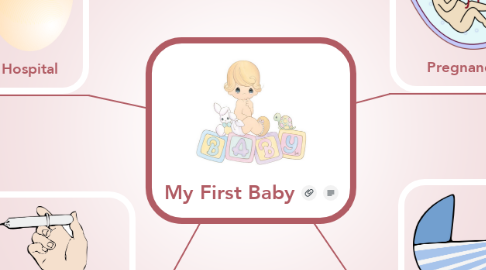
1. Immunization Schedule
1.1. First year and after
1.1.1. At birth
1.1.1.1. Hepatitis B vaccine (HBV)
1.1.2. 1-2 months
1.1.2.1. Second dose HBV
1.1.3. 2 months
1.1.3.1. DTaP: Diphtheria, tetanus, and acellular pertussis vaccine
1.1.3.2. Hib: Haemophilus influenzae type b vaccine
1.1.3.3. IPV: Inactivated poliovirus vaccine
1.1.3.4. PCV: Pneumococcal conjugate vaccine
1.1.3.5. Rota: Rotavirus vaccine
1.1.4. 4 months
1.1.4.1. DTaP
1.1.4.2. Hib
1.1.4.3. IPV
1.1.4.4. PCV
1.1.4.5. Rota
1.1.5. 6 months
1.1.5.1. DTaP
1.1.5.2. Hib
1.1.5.3. PCV
1.1.5.4. Rota
1.1.6. 6 months and annually
1.1.6.1. Influenza
1.1.7. 6-18 months
1.1.7.1. HBV
1.1.7.2. IPV
2. Hospital
2.1. Hospital Bag Checklist
2.1.1. Labor
2.1.1.1. Your birth plan, medical notes and insurance papers
2.1.1.2. A comfortable nightshirt or old t-shirt to wear during labor
2.1.1.3. A Bathing suit or outfit you do not mind getting wet if you plan to use a birthing pool
2.1.1.4. Dressing gown, socks and slippers
2.1.1.5. Snacks, glucose candies and energy drinks
2.1.1.6. Lip balm
2.1.1.7. Hair ties or bands
2.1.1.8. Camera and spare batteries or charger
2.1.1.9. Mobile phone
2.1.2. After birth
2.1.2.1. Comfortable clothing and a going home outfit
2.1.2.2. Toiletries
2.1.2.3. Maternity pads
2.1.2.4. Breast pads and nipple cream
2.1.2.5. Nursing bras
2.1.2.6. Large cheap or disposable knickers
2.1.3. For the baby
2.1.3.1. A few bodysuits, sleep suits and a going home outfit
2.1.3.2. A receiving blanket
2.1.3.3. Socks and a hat
2.1.3.4. Muslin squares
2.1.3.5. Newborn diapers
2.1.3.6. Baby toiletries
2.1.3.7. Bottles and formula
2.1.3.8. Infant car seat
3. Pregnancy
3.1. Food
3.1.1. Good
3.1.1.1. Lean meat
3.1.1.2. Leafy vegetables
3.1.1.3. Whole grain bread
3.1.1.4. Unsaturated fats
3.1.1.5. (Non-fat) milk
3.1.1.6. Beans and lentils
3.1.1.7. Low mercury fish
3.1.1.8. Foods that are high in folate and Vitamin B
3.1.1.9. Drink lots of water!
3.1.2. Bad
3.1.2.1. Soft cheese
3.1.2.2. Deli meats that have not been cooked
3.1.2.3. High mercury fish
3.1.2.4. Raw eggs
3.1.2.5. Alcohol
3.2. Check-up schedule
3.2.1. 8-12 weeks: Initial prenatal visit
3.2.2. Optional genetic counseling visit
3.2.3. First two trimesters: Prenatal visits continue every 4-6 weeks
3.2.4. 15 to 20 weeks: Quad Screen test
3.2.5. 27 or 28 weeks: Glucose challenge test
3.2.6. 28 to 36 weeks: After 28 weeks, prenatal visits continue every 2-3 weeks until 36 weeks.
3.2.7. 36 weeks: Pelvic exam and Group B Strep test
3.2.8. 36 to 40 weeks
3.2.9. 40+ weeks
4. Checklist
4.1. Diaper and Layetes
4.1.1. Wrap covers, cloth diapers or disposable diapers
4.1.2. Baby wipes or large washcloths
4.1.3. All in ones or T-shirts
4.1.4. Newborn hat
4.1.5. Crib blankets, crib sized comforter and quilt
4.1.6. Swaddling and receiving blankets
4.2. Baby Care
4.2.1. Natural body wash and shampoo
4.2.2. Pacifiers
4.2.3. Natural lotion or baby oil
4.2.4. Diaper cream
4.2.5. Safety scissors or nail clippers for babies
4.2.6. A baby bath or tub bath
4.3. The Baby's Gear
4.3.1. A baby carrier
4.3.2. The infant car seat
4.3.3. Stroller
4.3.4. Swing
4.3.5. Diaper bag
4.4. Safety and Health
4.4.1. Baby monitor
4.4.2. Nightlight
4.4.3. Infant acetaminophen drops
4.4.4. Digital thermometer
4.4.5. Nasal aspirator
4.5. Sleep
4.5.1. Crib bedding set
4.5.2. Extra sheets for bassinette and crib
4.5.3. Crib mattress
4.6. Feeding
4.6.1. Bottles
4.6.2. Nipples of various flow stages
4.6.3. A bottle brush for cleaning
4.6.4. Drying rack for bottles
